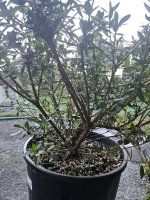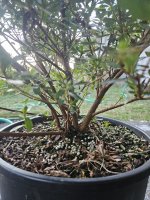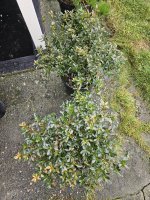Bubsamecium
Seedling
Hi everyone, I picked up these two Osakazuki satsukis in 3 gallon pots the other week, here's a close up of the trunk and an overhead view. I am very much a beginner when it comes to satsuki azaleas, but I have been using Rick Garcia's book, @Deep Sea Diver 's Evergreen Azalea Basics, including Satsuki doc, Joe Harris's lecture on Bonsai Mirai, Satsuki Channel on Youtube and other youtube videos, among a lot of very helpful posts here on BNut and around the internet for guidance.
I'd like to grow these two significantly larger while starting to set some structure for a few years before moving into training pots and starting to style and refine.
I'm in the middle of a front yard project and would be able to set aside some space to field grow- in which case what soil mix should I use? I can get a bulk rhododendron mix (bark (primarily fir and hemlock I believe) mulch and soil) readily, but not sure if it would need better drainage or other components.
Alternatively, I can repot and pot up; I do have a bag of kanuma (but it is quite expensive) and easy access to pumice, but I know it might be more economical to save that for a later refining stage. I could also pick up some peat and pumice and bark mulch as a developmental soil mix instead.
For repotting, I understand bare rooting and root washing is optimal; I could use some advice for how to root wash.
I was quite amazed by the trees shown here
(thanks @Glaucus for the suggestion!), but I'm not sure how to apply that technique to a small nursery tree; what I took away from it was: only prune once a year- in the late winter (but prune small buds on the inside or buds coming off the roots any time). Keep only 2-3 strong buds on each branch, let them lengthen. But in the same video I see him leaving no buds on some branches, and I'm not sure if he's pruning to last year's growth or beyond (going against some tips I've heard on BNut and Joe Harris to always leave a small amount of this year's growth when pruning back).
I'm also not sure how to achieve that spectacular trunk and branch thickening, especially seeing @Glaucus's experience with the Violetta.
Both of these nursery trees are quite shrubby with large branches emerging from/below the soil line. When would you prune back some branches as part of this primary development (selecting primary branches)? If the larger branches need pruning, do they need special attention- eg. pruning halfway through or leaving a few cm (inch) stub and then pruning it back convex close to flush the following year to avoid root die back?
Speaking of selecting primary branches, should I wire now for some general curves and shape, noting that I don't know what design direction to take these plants in just yet?
Another concern is some yellowing at the tips, which has happened since I got the plants. My best guesses are that it might be related to overwatering (they got a ton of rain overnight one night in particular), or could it be normal seasonal change? I'm also a bit concerned I've seen some white flies in the back yard where they are now... Does this necessitate an emergency repot? I suspect the first frost where I am (coastal 9a PNW) won't arrive for another month, and I do have a garage-ish area to shelter if need be.
Thanks in advance everyone for your thoughts and suggestions!
I'd like to grow these two significantly larger while starting to set some structure for a few years before moving into training pots and starting to style and refine.
I'm in the middle of a front yard project and would be able to set aside some space to field grow- in which case what soil mix should I use? I can get a bulk rhododendron mix (bark (primarily fir and hemlock I believe) mulch and soil) readily, but not sure if it would need better drainage or other components.
Alternatively, I can repot and pot up; I do have a bag of kanuma (but it is quite expensive) and easy access to pumice, but I know it might be more economical to save that for a later refining stage. I could also pick up some peat and pumice and bark mulch as a developmental soil mix instead.
For repotting, I understand bare rooting and root washing is optimal; I could use some advice for how to root wash.
I was quite amazed by the trees shown here
I'm also not sure how to achieve that spectacular trunk and branch thickening, especially seeing @Glaucus's experience with the Violetta.
Both of these nursery trees are quite shrubby with large branches emerging from/below the soil line. When would you prune back some branches as part of this primary development (selecting primary branches)? If the larger branches need pruning, do they need special attention- eg. pruning halfway through or leaving a few cm (inch) stub and then pruning it back convex close to flush the following year to avoid root die back?
Speaking of selecting primary branches, should I wire now for some general curves and shape, noting that I don't know what design direction to take these plants in just yet?
Another concern is some yellowing at the tips, which has happened since I got the plants. My best guesses are that it might be related to overwatering (they got a ton of rain overnight one night in particular), or could it be normal seasonal change? I'm also a bit concerned I've seen some white flies in the back yard where they are now... Does this necessitate an emergency repot? I suspect the first frost where I am (coastal 9a PNW) won't arrive for another month, and I do have a garage-ish area to shelter if need be.
Thanks in advance everyone for your thoughts and suggestions!



